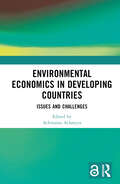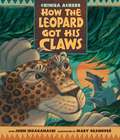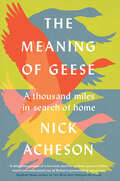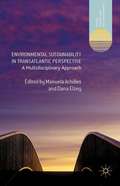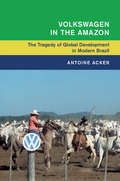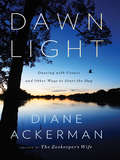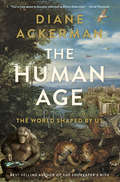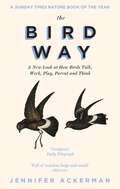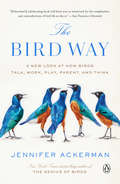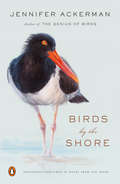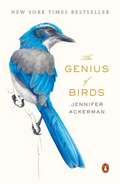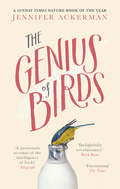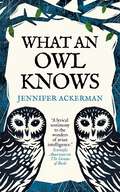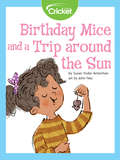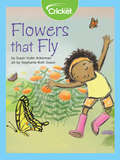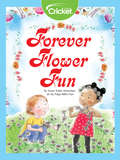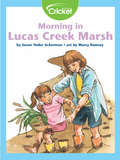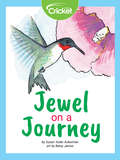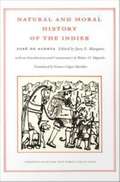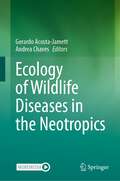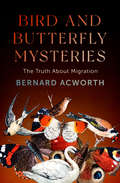- Table View
- List View
Environmental Economics in Developing Countries: Issues and Challenges
by Achiransu AcharyyaThe COVID-19 pandemic has laid bare the vulnerabilities of socio-economic systems globally and exposed the risks that natural capital degradation imposes on human health, economy, and society. This book studies the environmental challenges faced by developing economies in a post-COVID-19 world. Exploring diverse case studies from South Asia and Sub-Saharan Africa, the volume discusses the impact that economic development and, recently, COVID-19 has had on the environment, ecology, and economy of these regions. It analyses nature conservation policies aimed at minimizing ecological damage arising from economic development and discusses the policy objectives of sustainable development. It also highlights the significant role that environmental economics networks have played in capacity building, framing of policies using ecological economics tools, and developing a local leadership trained in addressing local sustainability issues. An important contribution to the study of environmental economics of the Global South, the book will be of interest to students and researchers of economics, environment, development studies, development economics, environmental policies, and South Asia studies. It will also be useful for policymakers and NGOs working in this field.
How the Leopard got his Claws
by Chinua AchebeIn the beginning, all the animals lived as friends. Their king, the leopard, was strong but gentle and wise. Only Dog had sharp teeth, and only he scoffed at the other animals’ plan to build a common shelter for resting out of the rain. But when Dog is flooded out of his own cave, he attacks the leopard and takes over as king. And it is then, after visiting the blacksmith’s forge and knocking on Thunder’s door, that the angry leopard returns to regain his throne by the menace of his own threatening new claws. In a riveting fable for young readers about the potency and dangers of power taken by force, Nigerian writer Chinua Achebe, author of Things Fall Apart, evokes themes of liberation and justice that echo his seminal novels about post-colonial Africa.
The Meaning of Geese: A Thousand Miles in Search of Home
by Nick Acheson‘A magisterial diary for bird lovers.’ Observer ⭐⭐⭐⭐ The Telegraph As seen on BBC Winterwatch 2023 ‘Honest, human and heart-grabbing. I loved this book so much.’ Sophie Pavelle, author of Forget Me Not ‘Delightful’ Stephen Moss, author of Ten Birds that Changed the World ‘Fascinating and thought-provoking’ Jake Fiennes, author of Land Healer ‘Awe-filled and absorbing’ Nicola Chester, author of On Gallows Down The Meaning of Geese is a book of thrilling encounters with wildlife, of tired legs, punctured tyres and inhospitable weather. Above all, it is the story of Nick Acheson’s love for the land in which he was born and raised, and for the wild geese that fill it with sound and spectacle every winter. Renowned naturalist and conservationist Nick Acheson spent countless hours observing and researching wild geese, transported through all weathers by his mother’s 40-year-old trusty red bicycle. He meticulously details the geese’s arrival, observing what they mean to his beloved Norfolk and the role they play in local people’s lives – and what role the birds could play in our changing world. During a time when many people faced the prospect of little work or human contact, Nick followed the pinkfeet and brent geese that filled the Norfolk skies and landscape as they flew in from Iceland and Siberia. In their flocks, Nick encountered rarer geese, including Russian white-fronts, barnacle geese and an extremely unusual grey-bellied brant, a bird he had dreamt of seeing since thumbing his mother’s copy of Peter Scott’s field guide as a child. To honour the geese’s great athletic migrations, Nick kept a diary of his sightings as well as the stories he discovered through the community of people, past and present, who loved them, too. Over seven months Nick cycles over 1,200 miles – the exact length of the pinkfeet’s migration to Iceland.
Environmental Sustainability in Transatlantic Perspective: A Multidisciplinary Approach
by Manuela Achilles Dana ElzeyExperts from business, academia, governmental agencies and non-profit think tanks to form a transnational and multi-disciplinary perspectives on the combined challenges of environmental sustainability and energy security in the United States and Germany.
Global and International History: The Tragedy of Global Development in Modern Brazil (Global and International History)
by Antoine AckerFrom 1973 to 1987, Volkswagen's (VW) 140,000 hectare 'pioneer' cattle ranch on the Amazon frontierlaid barethe limits of capitalist development. These limits were not only economic, with the core management of a multinational company engaged in the 'integration' of an extreme world periphery, but they were also legal and ethical, with the involvement of indentured labor and massive forest burning. Its physical limits were exposed by an unpredictable ecosystem refusing to submit to VW's technological arsenal. Antoine Acker reveals how the VW ranch, a major project supported by the Brazilian military dictatorship, was planned, negotiated, and eventually undone by the intervention of internationally connected actors and events.
Dawn Light: Dancing with Cranes and Other Ways to Start the Day
by Diane AckermanA celebrated storyteller-poet-naturalist explores a year of dawns in her most personal book to date. In an eye-opening sequence of personal meditations through the cycle of seasons, Diane Ackerman awakens us to the world at dawn--drawing on sources as diverse as meteorology, world religion, etymology, art history, poetry, organic farming, and beekeeping. As a patient and learned observer of animal and human physiology and behavior, she introduces us to varieties of bird music and other signs of avian intelligence, while she herself "migrates" from winter in Florida to spring, summer, and fall in upstate New York. Humans might luxuriate in the idea of being "in" nature, Ackerman points out, but we often forget that we are nature--for "no facet of nature is as unlikely as we, the tiny bipeds with the giant dreams." Joining science's devotion to detail with religion's appreciation of the sublime, Dawn Light is an impassioned celebration of the miracles of evolution--especially human consciousness of our numbered days on a turning earth.
The Human Age: The World Shaped By Us
by Diane AckermanAs Diane Ackerman writes in her brilliant new book, The Human Age, "our relationship with nature has changed...radically, irreversibly, but by no means all for the bad. Our new epoch is laced with invention. Our mistakes are legion, but our talent is immeasurable." Ackerman is justly celebrated for her unique insight into the natural world and our place in it. In this landmark book, she confronts the unprecedented reality that one prodigiously intelligent and meddlesome creature, Homo sapiens, is now the dominant force shaping the future of planet Earth. Humans have "subdued 75 percent of the land surface, concocted a wizardry of industrial and medical marvels, strung lights all across the darkness." We tinker with nature at every opportunity; we garden the planet with our preferred species of plants and animals, many of them invasive; and we have even altered the climate, threatening our own extinction. Yet we reckon with our own destructive capabilities in extraordinary acts of hope-filled creativity: we collect the DNA of vanishing species in a "frozen ark," equip orangutans with iPads, and create wearable technologies and synthetic species that might one day outsmart us. With her distinctive gift for making scientific discovery intelligible to the layperson, Ackerman takes us on an exhilarating journey through our new reality, introducing us to many of the people and ideas now creating--perhaps saving--our future and that of our fellow creatures. A beguiling, optimistic engagement with the changes affecting every part of our lives, The Human Age is a wise and beautiful book that will astound, delight, and inform intelligent life for a long time to come.
A Natural History of Love: Author of the National Bestseller A Natural History of the Senses
by Diane AckermanThe bestselling author of A Natural History of the Senses now explores the allure of adultery, the appeal of aphrodisiacs, and the cult of the kiss. Enchantingly written and stunningly informed, this "audaciously brilliant romp through the world of romantic love" (Washington Post Book World) is the next best thing to love itself.
Technology in American Water Development (RFF Water Policy Set)
by Edward A. Ackerman George O.G. LoffFirst Published in 2011. Routledge is an imprint of Taylor & Francis, an informa company.
Poisoned for Pennies: The Economics of Toxics and Precaution
by Frank Ackerman"Cost-benefit analysis" is a term that is used so frequently we rarely stop to think about it. But relying on it can lead to some dubious conclusions, as Frank Ackerman points out in this eye-opening book. For example, some economists have argued that states should encourage--and even subsidize--cigarette smoking by citizens because smoking will shorten life spans and therefore reduce the need and expense of caring for the elderly. How did the economists reach that conclusion? The answer is cost-benefit analysis, Ackerman explains. Then in clear, understandable language, he describes an alternative, precautionary approach to making decisions under uncertainty. Once a mere theory, the precautionary principle has now been applied in practice through the European Union's REACH protocol. Citing major studies, many of which he has directed, he shows that the precautionary approach has not only worked, but has been relatively cheap. Poisoned for Pennies shows how the misuse of cost-benefit analysis is impeding efforts to clean up and protect our environment, especially in the case of toxic chemicals. According to Ackerman, conservatives--in elected office, in state and federal regulatory agencies, and in businesses of every size--have been able to successfully argue that environmental clean-up and protection are simply too expensive. But he proves, that is untrue in case after case. Ackerman is already well known for his carefully reasoned attacks on the conventional wisdom about the costs of environmental regulation. This new book, which finds Ackerman ranging from psychological research to risk analysis to the benefits of aggressive pesticide regulation, and from mad cow disease to lead paint, will further his reputation as a thought leader in environmental protection. We can't afford not to listen to him.
The Bird Way: A New Look at How Birds Talk, Work, Play, Parent, and Think
by Jennifer Ackerman'A celebration of the dizzying variety of bird life and behaviour, one that will enthral birders and non-birders alike' The ObserverFrom the New York Times bestselling author of The Genius of Birds, a radical investigation into the bird way of being, and the recent scientific research that is dramatically shifting our understanding of birds. 'There is the mammal way and there is the bird way.' This is one scientist's pithy distinction between mammal brains and bird brains: two ways to make a highly intelligent mind. But lately, scientists have taken a new look at bird behaviours they've previously dismissed as anomalies. What they're finding is upending the traditional view of how birds live, how they communicate, forage, court, survive. They're also revealing the remarkable intelligence underlying these activities, abilities we once considered uniquely our own - deception, manipulation, kidnapping, infanticide, but also, ingenious communication between species, collaboration, altruism and play. Some of these behaviours are biological conundrums that seem to push the edges of - well - birdness: A mother bird that kills her own infant sons, and another that selflessly tends to the young of other birds. Young birds that devote themselves to feeding their siblings and others so competitive they'll stab their nestmates to death. Birds that give gifts and birds that steal, birds that dance or drum, that paint their creations or paint themselves, and birds that summon playmates with a special call - and may hold the secret to our own penchant for playfulness and the evolution of laughter. Drawing on personal observations, the latest science, and her bird-related travel around the world, Ackerman shows there is clearly no single bird way of being. In every respect, in plumage, form, song, flight, lifestyle, niche, and behaviour, birds vary. It's what we love about them.'Biologist and bestselling author Jennifer Ackerman knows what she's talking about . . . Chapter by meatily evidence-based chapter, she lays out the assumptions that underpin our understanding of birds - and then pecks them apart . . . Her knack for catching the personalities of different species in gorgeous, playful prose further collapses comfortable barriers between the human and the birdlike . . . More than it is a book about birds - and it is, indisputably, a book about birds - The Bird Way is about diversity and tolerance. A little bird told me that's just what we need in 2020' Daily Telegraph, ***** (Five Stars)'Jennifer Ackerman is not a field researcher, but with her eye for a great story she converts the scientific findings of others into popular books. The real joy of her book is its close attention to some of the specialists of the region . . . Ackerman is also alive to the humour at play in field research' Mark Cocker, The Spectator
The Bird Way: A New Look at How Birds Talk, Work, Play, Parent, and Think
by Jennifer AckermanFrom the New York Times bestselling author of The Genius of Birds, a radical investigation into the bird way of being, and the recent scientific research that is dramatically shifting our understanding of birds -- how they live and how they think.&“There is the mammal way and there is the bird way.&” But the bird way is much more than a unique pattern of brain wiring, and lately, scientists have taken a new look at bird behaviors they have, for years, dismissed as anomalies or mysteries –– What they are finding is upending the traditional view of how birds conduct their lives, how they communicate, forage, court, breed, survive. They are also revealing the remarkable intelligence underlying these activities, abilities we once considered uniquely our own: deception, manipulation, cheating, kidnapping, infanticide, but also ingenious communication between species, cooperation, collaboration, altruism, culture, and play. Some of these extraordinary behaviors are biological conundrums that seem to push the edges of, well, birdness: a mother bird that kills her own infant sons, and another that selflessly tends to the young of other birds as if they were her own; a bird that collaborates in an extraordinary way with one species—ours—but parasitizes another in gruesome fashion; birds that give gifts and birds that steal; birds that dance or drum, that paint their creations or paint themselves; birds that build walls of sound to keep out intruders and birds that summon playmates with a special call—and may hold the secret to our own penchant for playfulness and the evolution of laughter. Drawing on personal observations, the latest science, and her bird-related travel around the world, from the tropical rainforests of eastern Australia and the remote woodlands of northern Japan, to the rolling hills of lower Austria and the islands of Alaska&’s Kachemak Bay, Jennifer Ackerman shows there is clearly no single bird way of being. In every respect, in plumage, form, song, flight, lifestyle, niche, and behavior, birds vary. It is what we love about them. As E.O Wilson once said, when you have seen one bird, you have not seen them all.
Birds by the Shore: Observing the Natural Life of the Atlantic Coast
by Jennifer AckermanFrom the bestselling author of The Genius of Birds, the revised and reissued edition of her beloved book of essays describing her forays along the Delaware shoreFor three years, Jennifer Ackerman lived in the small coastal town of Lewes, Delaware, in the sort of blue-water, white-sand landscape that draws summer crowds up and down the eastern seaboard. Birds by the Shore is a book about discovering the natural life at the ocean's edge: the habits of shorebirds and seabirds, the movement of sand and water, the wealth of creatures that survive amid storm and surf. Against this landscape's rhythms, Ackerman revisits her own history--her mother's death, her father's illness and her hopes to have children of her own.This portrait of life at the ocean's edge will be relished by anyone who has walked a beach at sunset, or watched a hawk hover over a winter marsh, and felt part of the natural world. With a quiet passion and friendly, generous intelligence, it explores the way that landscape shapes our thoughts and perceptions and shows that home ground is often where we feel the deepest response to the planet.
The Genius of Birds
by Jennifer Ackerman<P>Birds are astonishingly intelligent creatures. In fact, according to revolutionary new research, some birds rival primates and even humans in their remarkable forms of intelligence. Like humans, many birds have enormous brains relative to their size. Although small, bird brains are packed with neurons that allow them to punch well above their weight. <P> In The Genius of Birds, acclaimed author Jennifer Ackerman explores the newly discovered brilliance of birds and how it came about. As she travels around the world to the most cutting-edge frontiers of research-- the distant laboratories of Barbados and New Caledonia, the great tit communities of the United Kingdom and the bowerbird habitats of Australia, the ravaged mid-Atlantic coast after Hurricane Sandy and the warming mountains of central Virginia and the western states--Ackerman not only tells the story of the recently uncovered genius of birds but also delves deeply into the latest findings about the bird brain itself that are revolutionizing our view of what it means to be intelligent. <P>Consider, as Ackerman does, the Clark's nutcracker, a bird that can hide as many as 30,000 seeds over dozens of square miles and remember where it put them several months later; the mockingbirds and thrashers, species that can store 200 to 2,000 different songs in a brain a thousand times smaller than ours; the well-known pigeon, which knows where it's going, even thousands of miles from familiar territory; and the New Caledonian crow, an impressive bird that makes its own tools. <P>But beyond highlighting how birds use their unique genius in technical ways, Ackerman points out the impressive social smarts of birds. They deceive and manipulate. They eavesdrop. They display a strong sense of fairness. They give gifts. They play keep-away and tug-of-war. They tease. They share. They cultivate social networks. They vie for status. They kiss to console one another. They teach their young. They blackmail their parents. They alert one another to danger. They summon witnesses to the death of a peer. They may even grieve. <P>This elegant scientific investigation and travelogue weaves personal anecdotes with fascinating science. Ackerman delivers an extraordinary story that will both give readers a new appreciation for the exceptional talents of birds and let them discover what birds can reveal about our changing world. Incredibly informative and beautifully written, The Genius of Birds richly celebrates the triumphs of these surprising and fiercely intelligent creatures. <P><b>A New York Times Bestseller</b>
The Genius of Birds
by Jennifer AckermanBirds are astonishingly intelligent creatures. In fact, according to revolutionary new research, some birds rival primates and even humans in their remarkable forms of intelligence. Like humans, many birds have enormous brains relative to their size. Although small, bird brains are packed with neurons that allow them to punch well above their weight.In The Genius of Birds, acclaimed author Jennifer Ackerman explores the newly discovered brilliance of birds and how it came about. As she travels around the world to the most cutting-edge frontiers of research - the distant laboratories of Barbados and New Caledonia, the great tit communities of the United Kingdom and the bowerbird habitats of Australia, the ravaged mid-Atlantic coast after Hurricane Sandy and the warming mountains of central Virginia and the western states - Ackerman not only tells the story of the recently uncovered genius of birds but also delves deeply into the latest findings about the bird brain itself that are revolutionizing our view of what it means to be intelligent.Consider, as Ackerman does, the Clark's nutcracker, a bird that can hide as many as 30,000 seeds over dozens of square miles and remember where it put them several months later; the mockingbirds and thrashers, species that can store 200 to 2,000 different songs in a brain a thousand times smaller than ours; the well-known pigeon, which knows where it's going, even thousands of miles from familiar territory; and the New Caledonian crow, an impressive bird that makes its own tools.But beyond highlighting how birds use their unique genius in technical ways, Ackerman points out the impressive social smarts of birds. They deceive and manipulate. They eavesdrop. They display a strong sense of fairness. They give gifts. They play keep-away and tug-of-war. They tease. They share. They cultivate social networks. They vie for status. They kiss to console one another. They teach their young. They blackmail their parents. They alert one another to danger. They summon witnesses to the death of a peer. They may even grieve.This elegant scientific investigation and travelogue weaves personal anecdotes with fascinating science. Ackerman delivers an extraordinary story that will both give readers a new appreciation for the exceptional talents of birds and let them discover what birds can reveal about our changing world.
What an Owl Knows: The New Science of the World's Most Enigmatic Birds
by Jennifer Ackerman*THE NEW YORK TIMES BESTSELLER* &‘And if anyone knows anything about anything…it's Owl who knows something about something.&’ Winnie-the-Pooh, A. A. Milne From prehistoric cave paintings to the prints and etchings of Picasso, owls have captivated and inspired us for millennia. Whether they appear as ancient Athenian symbols of wisdom, ghostly harbingers of death, or the cuddly sidekicks of Harry Potter and Winnie the Pooh, these birds have continued to fascinate and disturb us in equal measure. Through revelatory new behavioural research, Jennifer Ackerman provides an intimate glimpse into these magnificent creatures&’ lives. From the evolutionary quirks behind their silent flight and rotating heads, to their romantic relationships and parenting styles, What an Owl Knows brings the rich natural history of owls to life. Deftly weaving together science and art, Ackerman journeys into the owl&’s moonlit world and asks: what is it about these birds that so enthrals us?
Birthday Mice and a Trip Around the Sun
by Susan Yoder AckermanA girl named Nina celebrates her birthday with her family and enjoys eating chocolate mice—her favorite treat! When she wants more, her mother says that she must wait a year. Eager with anticipation, she celebrates other holidays and enjoys the seasons. By her sixth birthday, she can't wait to enjoy the chocolate mouse treats again!
Flowers that Fly
by Susan Yoder AckermanSimon teaches his little cousin Adeline about how to grow a garden that will attract beautiful butterflies.
Forever Flower Fun
by Susan Yoder AckermanThere are so many fun things to do outside during the summer! When the flowers bloom, there is flower fun for everyone! When their hollyhock ladies and daisy chains wilt, Lily Rose and her friend learn how to preserve flowers by drying them. There's always an adventure in nature!
Morning in Lucas Creek Marsh
by Susan Yoder AckermanThomas, Madeline, and their mother go on a walk through a Virginia tidewater marsh, spotting all kinds of wildlife along the way.
Jewel on a Journey
by Susan Yoder Ackerman Betsy JamesTrey and Susannah hear a loud thump and learn that the fallen tiny bird laying on their deck is a Hummingbird! Miss Nora, their neighbor, cares for birds and may be able to help them save the bird. Discover what Miss Nora does to help the Hummingbird. Will the injured bird fly again?
Dolefully, A Rampart Stands (Penguin Poets)
by Paige Ackerson-KielyA collection of haunting, image-rich poems about isolation, captivity, and vanishing.The poems in Paige Ackerson-Kiely's third collection are set primarily in the rural northeast of America, and explore rural poverty, entrapment, captivity, violence, and a longing to vanish. Ranging from free verse to a long noir prose poem, they examine who her, or our, "captors" might be. Ackerson-Kiely is interested in characters who are aware of their foibles, and who find ways to turn away from those problems in search of connection and freedom.
Natural and Moral History of the Indies
by José De AcostaThe Natural and Moral History of the Indies, the classic work of New World history originally published by José de Acosta in 1590, is now available in the first new English translation to appear in several hundred years. A Spanish Jesuit, Acosta produced this account by drawing on his own observations as a missionary in Peru and Mexico, as well as from the writings of other missionaries, naturalists, and soldiers who explored the region during the sixteenth century. One of the first comprehensive investigations of the New World, Acosta's study is strikingly broad in scope. He describes the region's natural resources, flora and fauna, and terrain. He also writes in detail about the Amerindians and their religious and political practices. A significant contribution to Renaissance Europe's thinking about the New World, Acosta's Natural and Moral History of the Indies reveals an effort to incorporate new information into a Christian, Renaissance worldview. He attempted to confirm for his European readers that a "new" continent did indeed exist and that human beings could and did live in equatorial climates. A keen observer and prescient thinker, Acosta hypothesized that Latin America's indigenous peoples migrated to the region from Asia, an idea put forth more than a century before Europeans learned of the Bering Strait. Acosta's work established a hierarchical classification of Amerindian peoples and thus contributed to what today is understood as the colonial difference in Renaissance European thinking.
Ecology of Wildlife Diseases in the Neotropics
by Gerardo Acosta-Jamett Andrea ChavesThis contributed volume focuses on the Neotropical region, and explores the environmental, ecological and socio-economic components that facilitate the emergence of zoonotic diseases. This book highlights the primary ecological, environmental, social, and economic variables associated with the risk of maintenance, transmission, and dissemination of emerging, re-emerging, and neglected infectious diseases, in which Neotropical vertebrates are involved. It compiles up-to-date knowledge and research for the neotropical region, as well as discusses the current needs of knowledge improvement. The chapters include various examples of the cycles of infectious diseases, all with world-wide relevance where neotropical wild vertebrates are affected or involved.
Bird and Butterfly Mysteries: The Truth About Migration
by Bernard AcworthAs part of his challenge to the theory of evolution, the outspoken creationist presents alternative theories of bird flight and migration. In 1932, Bernard Acworth established the Evolution Protest Movement (now called the Creation Science Movement) for the purpose of criticizing evolutionary theory in scientific terms. A freelance journalist and amateur ornithologist, he took aim at the accepted science of ornithology with a keenly skeptical eye. Here, Acworth addresses topics including bird and butterfly migration, and the peculiarities of the cuckoo. In Bird and Butterfly Mysteries, Acworth presents a close examination of the science concerning the flight of winged animals. Through this analysis, he exposes errors that call into question many of the major conclusions reached by professional ornithologists. While the two Laws of Currents Acworth proposes in this volume have since appeared in other works on ornithology, he has never received due credit for their discovery.
